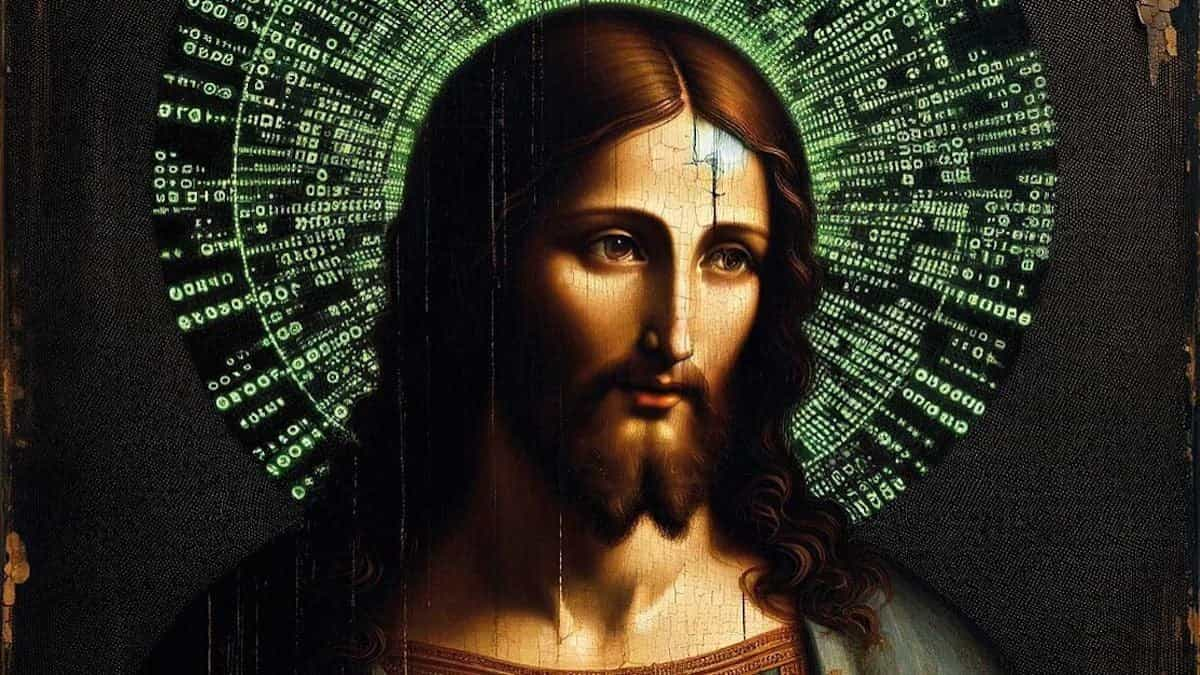Show table of content Hide table of content
In a groundbreaking fusion of faith and technology, the Saint Peter’s Chapel in Lucerne, Switzerland has created a unique spiritual experience that allows visitors to interact with an AI-powered Jesus Christ. This innovative installation, named “Deus In Machina,” represents a bold experiment in how religious institutions might embrace artificial intelligence to create new forms of spiritual connection in our increasingly digital world.
Digital divinity: how AI Jesus works in the Swiss chapel
The Saint Peter’s Chapel in Lucerne unveiled its AI Jesus installation in late November 2024, captivating both the religious community and technology enthusiasts. Developed by academics from Lucerne University of Applied Sciences and Arts, this digital representation of Christ draws its knowledge exclusively from the New Testament.
Visitors experience this divine digital encounter in a setting reminiscent of traditional confession. The AI Jesus appears on a computer screen placed inside a confessional booth, creating a blend of ancient religious practice and cutting-edge technology. What makes this system particularly accessible is its impressive linguistic capabilities—the AI can communicate with faithful visitors in over 100 different languages.
AI Google CEO unveils the real threat to humanity from AI, and it has nothing to do with jobs.
During these conversations, the digital Christ offers guidance based on biblical verses, providing spiritual advice that remains faithful to scripture. The technology behind this system shares similarities with other AI innovations that continue to reshape our world, much like Elon Musk’s controversial space station proposals are reshaping our understanding of human presence in space.
According to chapel representatives, roughly 1,000 people participated in the experiment, engaging with the AI Jesus in meaningful dialogue. Many approached these conversations with genuine sincerity, asking profound questions about faith, existence, and morality.
Spiritual conversations in the digital age
The nature of these AI-facilitated spiritual dialogues has proven surprisingly profound. Participants engaged with the digital Christ on a range of deep theological and social issues. Many conversations centered on fundamental questions about God’s existence and purpose, while others addressed contemporary moral challenges facing religious institutions.
Theologian Marco Schmid, who analyzed data from these interactions, reports that participants discussed everything from global conflicts to the church’s positions on controversial topics like homosexuality and clerical abuse scandals. These conversations reflect similar soul-searching that happens in many modern contexts, as people seek answers to life’s big questions—not unlike how research on coffee’s life-extending properties makes us contemplate how to live better, healthier lives.
Importantly, chapel administrators emphasized that these AI interactions were not intended to replace traditional confession. Participants were explicitly instructed to avoid sharing personal information with the AI and were discouraged from making actual confessions. This boundary was established to maintain the experimental nature of the project while respecting the sacredness of traditional religious practices.
The conversations instead focused on broader philosophical and ethical discussions about humanity and our collective challenges. This approach allowed participants to engage with religious concepts in a novel format while preserving the unique role of human clergy in providing personal spiritual guidance.
Faith meets technology: reactions and implications
The introduction of AI Jesus has generated mixed reactions among participants. While many found the experience intriguing, Schmid noted that some faithful visitors expressed reservations about the lack of true confidentiality. Traditional confession offers a sacred privacy that, by necessity, cannot be fully replicated in a digital experiment where data might be collected for research purposes.
This experiment raises fascinating questions about how religious institutions might incorporate emerging technologies. Just as NASA’s historic footage of Martian weather phenomena changes our understanding of the universe, AI spiritual guides might transform how we conceptualize religious experience.
News This TikToker buys a used van and realizes it has a hidden surveillance device.
The chapel’s initiative reflects a broader trend of religious institutions seeking relevance in an increasingly digital world. Rather than rejecting technological advances, some faith communities are exploring how these tools might enhance spiritual practice while maintaining doctrinal integrity. This adaptation shows religion’s remarkable resilience across centuries of technological and social change.
While some traditionalists question whether AI can authentically represent divine wisdom, others see potential for technology to make religious teachings more accessible. The experiment has sparked discussions similar to those surrounding influential social media personalities who shape modern discourse on values and beliefs.
The future of religious experience
As AI continues to evolve, religious institutions worldwide are watching the Lucerne experiment with interest. The “Deus In Machina” installation provides valuable insights into how spiritual seekers might engage with faith traditions through technological interfaces.
Religious leaders must now navigate complex questions about authenticity, authority, and the essence of spiritual connection. Can an algorithm meaningfully convey divine wisdom? Does the digital medium enhance or diminish the sanctity of religious teachings? These questions have no simple answers but will shape how faith communities approach technology in coming decades.
What remains clear from the Saint Peter’s Chapel experiment is that human hunger for spiritual guidance persists even in our technological age. Participants sought meaningful answers to life’s deepest questions, regardless of whether those answers came from a human priest or a digital representation of Jesus.
The future might see more sophisticated religious AI applications, perhaps with greater personalization or deeper scriptural knowledge. Yet the Lucerne experiment suggests that any successful integration of technology into religious practice must balance innovation with respect for traditions that have sustained believers for centuries.


